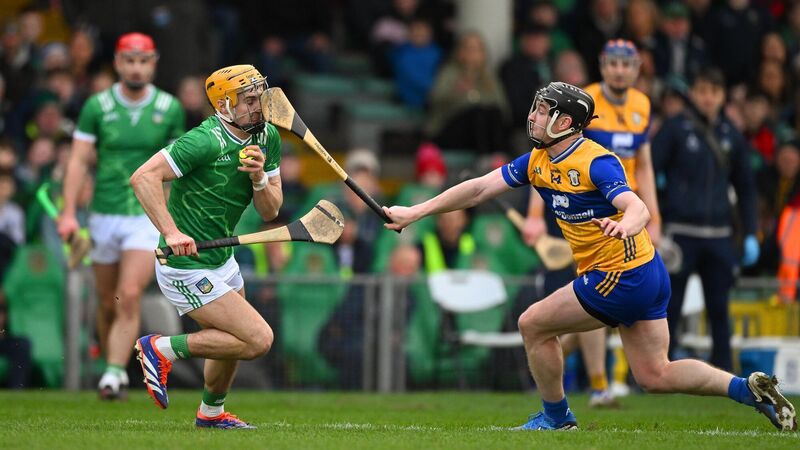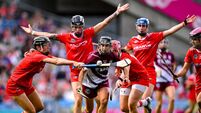Hurling referees told to 'tighten up' on the rules

YELLOW PERIL: Adam English of Limerick is fouled by Tony Kelly of Clare, for which Kelly was shown a yellow card, during the Allianz Hurling League Division 1A match between Limerick and Clare at TUS Gaelic Grounds in Limerick. Photo by Brendan Moran/Sportsfile
Inter-county hurling referees have been told to “tighten up” their application of the rules ahead of this weekend’s Allianz League Round 5 games.
At an online meeting on Thursday, administrators directed referees to impose appropriate sanctions after a number of head-high fouls were not punished sufficiently this past weekend.
In Limerick on Sunday, Tony Kelly’s hurley made contact with Adam English’s head and there was a similar incident between Mike Casey and Jack O’Neill. Also on Sunday, Dublin’s Cian O’Sullivan was dismissed for a high shoulder on Waterford defender Mark Fitzgerald in the second half of their Division 1B game in Walsh Park.
On Saturday evening, a similar foul by Kilkenny’s Cian Kenny on Cork half-back Ciarán Joyce was not considered a red card offence. While Kelly was booked for his offence by referee Thomas Walsh in TUS Gaelic Grounds, Casey did not and in SuperValu Páirc Uí Chaoimh Johnny Murphy also chose not to give a card to Kenny.
Clare captain Kelly admitted he was fortunate not to be sent off for the first-half incident. “Look, on another day, another referee could have sent you off for it,” he told TG4. “I committed to trying to get to the ball. In fairness, I got the benefit of the doubt from the referee on other days they could go against.”
Rule 5.19 of the GAA’s Official Guide states “to behave in any way which is dangerous to an opponent, including to deliberately pull on or take hold of a faceguard or any other part of an opponent’s helmet” is a Category III offence, the punishment for which is a red card and a one-match ban.
Former Munster chairman Ger Ryan, who was head of the GAA’s medical, scientific and welfare committee 11 years ago when the rule was introduced, is now the chairman of the referees’ appointment body.
In 2022, hurlers were warned about making challenges around the head. “Players are responsible for the contact that they make. It doesn’t matter whether it was accidental. If he is responsible for the contact that he makes, then he has to take the repercussions of that contact.”
However, it's generally considered referees have taken a more relaxed approach to head-high fouls in recent times. While there is some mitigation when players duck into tackles or their heads are lowered, accidental contact between hurley and helmet has also been considered by some match officials as an extenuating reason not show a red card.
The melee that followed the Diarmaid Byrnes-Kelly clash, which eventually led to Byrnes’ sending off in Limerick last Sunday, has also been a hot topic in refereeing circles this week. To contribute to a melee is also considered a Category III/red card offence yet Walsh chose not to dismiss anyone other than the Limerick defender.
As well as advising zero tolerance for all head-high challenges, one of the Football Review Committee’s new rules is making it a black card offence to be the third or subsequent player entering a melee without the sole purpose of trying to remove a team-mate from the row.
Earlier this week, former Cork star Ben O’Connor complained about the calls for Kelly to be sent off. He also questioned why a linesman ordered off Harry Shine after the Kilkenny man cut his leg. “The poor corner forward for Kilkenny who had to go off and get his knee wiped. I don’t know where the game is going.”
However, Rule 1.5 (b) stipulates a player who is bleeding, or who has blood on any part of the body…” as a result of an injury sustained during play shall be instructed to immediately leave the field to receive medical attention.










